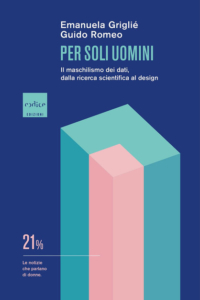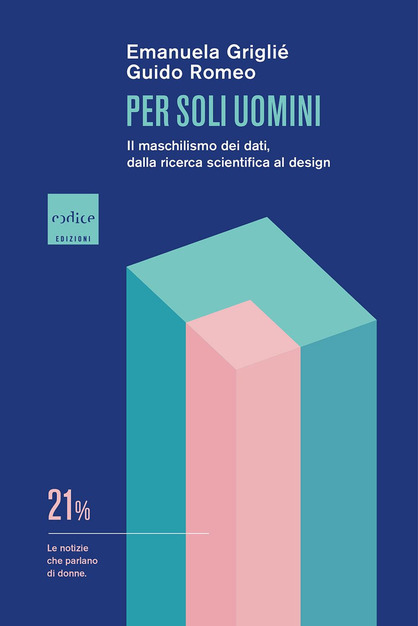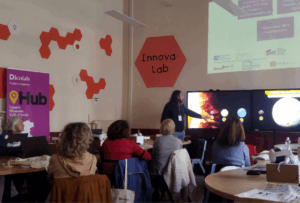
For Men Only. The machismo of data, from scientific research to design is a rich book with an anti-conventional approach written by Emanuela Griglié and Guido Romeo and published by Codice Edizioni in 2021, dedicated to the analysis of data that mark the gender disparity in science and technology, from design to industry, found in every sector of society.
The Authors – both journalists, Emanuela Griglié writes for “La Stampa” and “Repubblica Salute” about innovation, digital culture and science: Guido Romeo about economics and digital on “Il Sole 24 Ore” – have collected, analyzed and commented on relevant data, from the measurement of accidents at work to metrics employed in all fields from medicine to clothing, showing that our societies still function and develop with the metric of the “standard male”, the “human type” (height, weight, phenotype), which in reality represents a rather small minority in the world’s population, undoubtedly excluding here women and also many males themselves.
There are many gender biases in Artificial Intelligence, stereotypes adopted from the past that are reproduced equally in software and digital.
We talked about it with the Authors.
For men only
with Emanuela Griglié and Guido Romeo
Emanuela Griglié
The book was born from a positive need, to show the lines of change. In fact, we didn’t want it to be a book of complaints, presenting only the negative aspects that emerge when reading certain data, such as the fact that women are 75% more likely to suffer from the side effects of a medicine and 17% more likely to die in a car accident. We wanted to read other data as well: for example, not just the number of women who are harassed, abused or killed, but also the number of harassing and abusive men. We wanted to start a different narrative, telling not only the helpless female victim, but also that times have changed, there are many examples of reactions and an increased, though not widespread, sensitivity.
Language influences reality
There are many studies of neuroscientists, and from Jacques Lacan onwards, that confirm how important language is in influencing the representation of reality and therefore our behaviour. We construct our reality from language and in gender issues using precise language is crucial, especially for young girls and girls. For example, not admitting that certain professions are mainly for males is already influencing the future choices of girls. My daughter is 4 and a half years old and her father is an engineer; she asked me: “I can’t be an engineer because the word ‘engineer’ doesn’t exist”.
We started from the numbers, to propose new ways to look at the issue of gender equality, and we saw that the pandemic of COVID has worsened the situation of many women in the world taking into account that 75% of unpaid work worldwide is done by women. Reflecting on this data, we reflected on the fact that women always start with a handicap, a heavy ballast.
The structures of everyday life
Guido Romeo
I was urged to write this book by Emanuela – I write about innovation, I use data – and I, too, thought that a complaint book would not help. We thought that in many analyses of the problem there is a lack of reactive phase, the What do we do?
And missing is what we have called the infrastructural, systemic view of the problem: it is true, there are male chauvinist men, with a patriarchal view of the world, but there are above all the structures of everyday life that make solutions difficult, if they will remain as they are, there are our cities that are made a certain way, our work contracts, our social contracts, safety regulations, all the structures that beyond personal relationships shape the way we live, and create inequalities. Just to recall the maternity leave that needs to be changed by making it applicable for fathers as well. It would not be difficult and would already guarantee an improvement for both genders, but in Italy it is difficult to propose these solutions.
We were also interested in analyzing the points of change. We wrote the book during the lockdown period of COVID, and this must have partly influenced the outcome. The pandemic made many problems evident, and accelerated several changes already underway: it was a catalyst for thinking. One example, the Immuni app (an app made by the Italian Ministry of Health to manage behaviors during lockdown and beyond) that had as its icons a woman holding a baby and a man clearly ready to go to work. As soon as it was released to everyone it appeared unacceptable and was changed.
During the lockdown, we couldn’t move much, and this brought out even more the problem that many women face, trip-chaining, the chain of many different routes with intermediate stops for different errands perhaps before going to work. If in our cities everything was reachable in 15 minutes, if all the main facilities, public and private, were within a quarter of an hour, this would facilitate family management for many women. Barcelona already has these “cities in 15 minutes,” thanks to the “Super Illas,” mega-isolates that offer proximity services even in the center. Paris and Milan are moving in this direction.
Stereotypes harm everyone
Emanuela Griglié
In the various maps of hate on and off the net, females are the first target, before any other sector of the population, represented as a minority (even though we are the majority of the population).
But we have seen a change taking place in the younger generation and we have a lot of faith in today’s boys, many of whom grew up with parents who were sensitive to equality issues and who have digested this. It is perhaps more difficult for males to relate to this change because they often see themselves as unfairly – and we say this in the book – deprived of certain rights. But rights are not zero-sum, if you grant them to women you are not taking them away from men, you are simply creating a fairer society in which everyone lives better.
In the book we cite some data, even surprising: in more just societies, men also live better, sleep better, have less back pain, are even more satisfied with their sex life. Men should not feel intimidated by greater rights attributed to women, they would live in a more just society and they would feel relieved from having to adhere, too, to stereotypes of the type the standard male defined by the measures imposed by Le Corbusier and amplified by a productive model still Fordist. In fact, this is an old model that no longer exists and, in the end, is no longer liked even by the majority of males who demand more flexibility as we have seen with smart-working.
We are moving towards a more personalized society, depending on gender, personality and life of each of us, from medicine to tools to jobs to commercial offerings, and the one-size-fits-all world is an old construct.
Guido Romeo
I myself do not recognize myself in the so-called “standard” male. Certainly family matters a great deal in how we learn to see the world. We grow up and see the world through the eyes of our parents, and I honestly don’t know how much we can do to change certain social structures. We need to offer tools for a greater understanding of the world, especially to children. Today, the generation born with digital technology has many stimuli, the network is a point of encounter and exchange.
However, I would like to underline another place of change that is often little considered, if not disdained, and that instead can exert a considerable positive influence, and that is companies. Many cultural and artistic phenomena have taken hold because of commercial interests, think of the cultural revolution of the Sixties, or punk, which would not have been known without Vivienne Westwood.
Some companies have already changed. Volvo has its EVA, Equal Vehicle for All, line of vehicles on the market, designed around the anatomical, height, muscle mass and strength differences between men and women, which are crucial when it comes to safe driving and injury rates in car accidents.
The garment industry is also taking into account the differences between men and women, not in the sense of no gender, that’s a mistake too, it’s a denial. Customization gives dignity to the customer, whether they are women or non-standard men. These apparently secondary aspects have a great influence on young people who are more hooked on the problems of equality and sustainability, and who often consider those who don’t deal with them as uncool.
Emanuela Grigliè
One area in which there is still a lot to do although it is crucial is that of gender medicine, which has existed for 30 years but in fact it is still difficult for drugs to be tested for women even though there are many confirmed studies on the different effects of drugs between women and men. I do not know if the vaccines that are in use today have been tested for women and men.
A simple example: the masks are male size, for women they are often too big.
Guido Romeo
In fact, there is a European and U.S. legislation that requires double testing, e.g. in the field of cardiovascular medicine, where we know that women suffer from heart attack with different symptoms than men, and more difficult to recover from the disease.
Emanuela Grigliè
Do pharmaceutical companies comply with these regulations? Do we know for sure? Is there transparency in this? Let’s then think about the field of new technologies, almost all set up for and about males, where bias is everywhere, with a 1950s mentality of iconization between men and women.
Guido Romeo
Computer science is dominated by males, and here I come back to the issue of school curriculum and the need to offer girls the same, or even better, opportunities to pursue studies and careers in technoscience. Digital technologies are dominated by an old imagery, stylized on the male that semantic engines, software, and social consider privileged interlocutor. If Google’s libraries are based on the old texts, where the woman is in a subordinate position, they will import the old prejudices and biases and transfer them equally to their machines. Technology is not neutral but is a social construct and reflects how we all are, for better or worse
Change is there, but it is very slow: according to the statistics we report in the book, at the current rate, we will reach parity in 280 years.
Girls who want to pursue careers in science have a hard time. Apart from the fact that they are less than males, so the environment is already not open to them, once they enter and after the do and post doc, they will find themselves at an age of about 30 years having to decide between family and career and if they decide to have children they will have to suspend their career for a year and more, while their male colleagues will move on.
Pink quotas yes or no?
Emanuela Griglié
I am super in favour. Women don’t start out as equals and it’s not a question of meritocracy, but of a long chain of disadvantages. Just consider the Draghi government, the number of women in government, a total imbalance, despite the initial promises.
Guido Romeo
Pink quotas, I am honest, are needed, especially in Italy – the Nordic countries can afford to remove them, since their societies have internalized them – but they are not enough.
Even when they are applied, they are applied in a non-transparent manner, with co-optation mechanisms and direct calls always to women known in the circle and without ever “shuffling the cards”.
Two other aspects to be corrected are those pointed out by the Italian astrophysicist Simonetta Di Pippo, Director of the United Nations Office for Outer Space Affairs: the pink quotas are fine, but the available seats must be equally distributed. You can’t really respect pink quotas if you have, for example, two seats available for women and eight for men.
Another aspect highlighted by Simonetta Di Pippo is that of job interviews. It often happens that a decisive and assertive woman is preferred to a decisive and assertive man because those qualities, which in a man are considered positive, while in a woman manager are judged exaggerated and overbearing.









